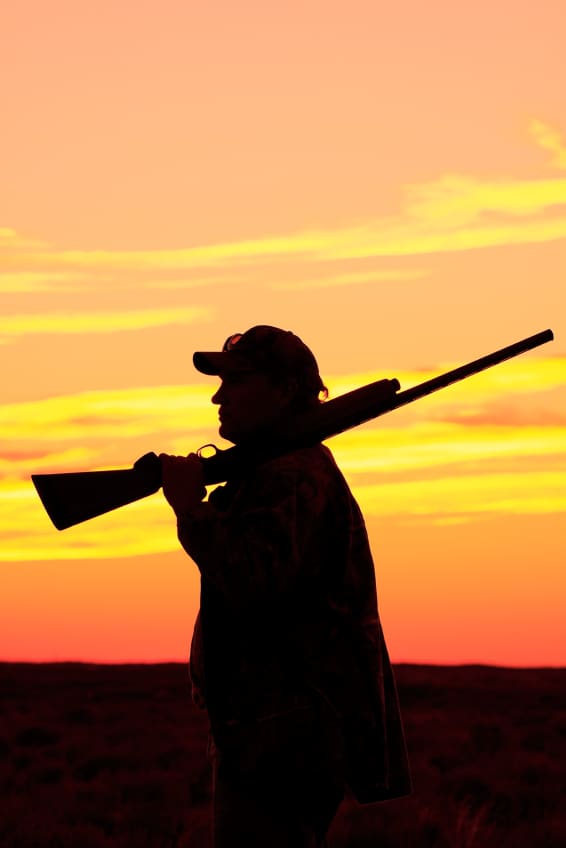What Every Hunter Should Know About Carrying Firearms
Hunter-ed 10.10.12

Looking at this picture, most people would say they see a hunter or shooter and a pretty sunrise. On the other hand, what most hunter education instructors would notice is guaranteed to make their skin crawl. Whether you’re knocking down clays at the skeet field or moving through brushy cover in search of pheasants, safely carrying firearms is a must. However, toting your gun the way that’s shown in the picture is an accident waiting to happen.
Why? Carrying a firearm slung over your shoulder like that lacks the most important element of safe firearms handling: muzzle control. Without muzzle control, you cannot guarantee that the muzzle is always pointed in a safe direction. If the hunter in the photo turned even slightly, the business end of that long gun could be pointing in the direction of domestic animals, buildings or even another person.
Often, this is the go-to carry when hunters are most tired. After a long day of tromping through thickets, it’s tempting to throw that gun up and let it sit on your shoulder like a seesaw. However, bear in mind it’s a one-handed carry. If the hunter trips, the firearm could easily slide off of the shoulder. Plus, with the trigger facing up or off to the side, branches and vegetation brushing against it could tamper with the safety and the trigger.
In recent years, I’ve seen pictures showing this carry creeping into hunting magazines and websites. I also now see examples of its evil twin, the African shoulder carry. This is where the gun teeters on top of the shoulder with the muzzle pointing forward. It’s sometimes used by those carrying the big, heavy guns used for African safaris, though I’ve seen it used in North America as well.
From a practical standpoint, this carry makes it virtually impossible to quickly shoulder your firearm. The real problem, though, is a lack of muzzle control. It’s human nature to turn toward the person you’re talking to. At the very least it will be a conversation killer if your companions find themselves staring down the muzzle of your rifle or shotgun. I’ve had several hunter education experts describe the worst case scenario, and it sends a shiver down my spine to think about it.
There are a couple of ways you can carry your gun safely while giving tired arms a break. For hunters with a break-action firearm, you can take a page out of the trap and skeet shooters’ playbook. Here’s how. Place the firearm at the hinge point on your shoulder with the barrel pointing down in front of you and your hand gripping the forestock.
The African sling or safari carry is another safe alternative. This is a sling carry but differs markedly from the American version because the muzzle points down and the firearm is carried on your support shoulder. For example, if you’re right handed, you’d use your left shoulder for the safari carry. This style of carry makes it surprisingly easy to shoulder your gun by following these steps:
- Grip the forearm with the support hand, raise the muzzle toward the target.
- When the muzzle is roughly parallel to the target, reach across with your shooting hand and grasp the stock.
- Rotate the gun 180 degrees and pull it into the pocket.
Though the safari carry may offer some relief for big game hunters headed to their hot spots, it’s not practical for upland bird hunters. Plus, because the muzzle is pointed down, it’s a carry to avoid if you’re moving through snow or muddy areas as you could end up with a plugged barrel.
By taking a hunter safety course, you can learn about several other safe gun carries including the two-handed or ready carry, trail carry, sling carry, elbow or side carry, cradle carry and shoulder carry. There’s no one method that’s safe for every situation. The one you choose should depend on where others are in relation to you (including dogs) and what type of terrain you’re hunting.
You can learn more by taking a hunting safety course online at www.hunter-ed.com. You can even take the course on your smartphone or tablet. The training offered at this site is approved by the state agencies responsible for hunter education, and it’s the same material students learn in the classroom.
Studying at hunter-ed.com is free. If you must be certified before buying a hunting license, you pay a one-time fee that is due only if you pass the test. Online hunter safety courses are available in participating states, so visit hunter-ed.com to take a course specific to your state.

